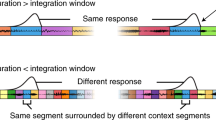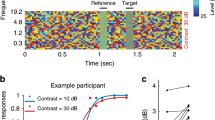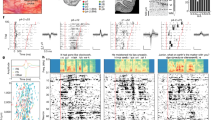Abstract
Mammals can hear sounds extending over a vast range of sound levels with remarkable accuracy. How auditory neurons code sound level over such a range is unclear; firing rates of individual neurons increase with sound level over only a very limited portion of the full range of hearing. We show that neurons in the auditory midbrain of the guinea pig adjust their responses to the mean, variance and more complex statistics of sound level distributions. We demonstrate that these adjustments improve the accuracy of the neural population code close to the region of most commonly occurring sound levels. This extends the range of sound levels that can be accurately encoded, fine-tuning hearing to the local acoustic environment.
This is a preview of subscription content, access via your institution
Access options
Subscribe to this journal
Receive 12 print issues and online access
$209.00 per year
only $17.42 per issue
Buy this article
- Purchase on Springer Link
- Instant access to full article PDF
Prices may be subject to local taxes which are calculated during checkout






Similar content being viewed by others
References
Christopher Kirk, E. & Smith, D.W. Protection from acoustic trauma is not a primary function of the medial olivocochlear efferent system. J. Assoc. Res. Otolaryngol. 4, 445–465 (2003).
Aubin, T. & Jouventin, P. Cocktail-party effect in king penguin colonies. Proc. R. Soc. Lond. B 265, 1665–1673 (1998).
Simmons, J.A., Wever, E.G. & Pylka, J.M. Periodical cicada: sound production and hearing. Science 171, 212–213 (1971).
Houtsma, A.J., Durlach, N.I. & Braida, L.D. Intensity perception XI. Experimental results on the relation of intensity resolution to loudness matching. J. Acoust. Soc. Am. 68, 807–813 (1980).
Viemeister, N.F. Auditory intensity discrimination at high frequencies in the presence of noise. Science 221, 1206–1208 (1983).
Viemeister, N.F. Intensity discrimination of noise in the presence of band-reject noise. J. Acoust. Soc. Am. 56, 1594–1600 (1974).
Evans, E.F. & Palmer, A.R. Relationship between the dynamic range of cochlear nerve fibres and their spontaneous activity. Exp. Brain Res. 40, 115–118 (1980).
Sachs, M.B. & Abbas, P.J. Rate versus level functions for auditory-nerve fibers in cats: tone-burst stimuli. J. Acoust. Soc. Am. 56, 1835–1847 (1974).
Colburn, H.S., Carney, L.H. & Heinz, M.G. Quantifying the information in auditory-nerve responses for level discrimination. J. Assoc. Res. Otolaryngol. 4, 294–311 (2003).
Viemeister, N.F. Intensity coding and the dynamic range problem. Hear. Res. 34, 267–274 (1988).
Winter, I.M. & Palmer, A.R. Intensity coding in low-frequency auditory-nerve fibers of the guinea pig. J. Acoust. Soc. Am. 90, 1958–1967 (1991).
Rees, A. & Palmer, A.R. Rate-intensity functions and their modification by broadband noise for neurons in the guinea pig inferior colliculus. J. Acoust. Soc. Am. 83, 1488–1498 (1988).
Gibson, D.J., Young, E.D. & Costalupes, J.A. Similarity of dynamic range adjustment in auditory nerve and cochlear nuclei. J. Neurophysiol. 53, 940–958 (1985).
May, B.J. & Sachs, M.B. Dynamic range of neural rate responses in the ventral cochlear nucleus of awake cats. J. Neurophysiol. 68, 1589–1602 (1992).
Dayan, P. & Abbott, L.F. Theoretical Neuroscience: Computational and Mathematical Modeling of Neural Systems (MIT Press, Cambridge, Massachusetts, 2001).
Pouget, A., Dayan, P. & Zemel, R.S. Inference and computation with population codes. Annu. Rev. Neurosci. 26, 381–410 (2003).
Johnson, D.H. & Kiang, N.Y. Analysis of discharges recorded simultaneously from pairs of auditory nerve fibers. Biophys. J. 16, 719–734 (1976).
Popelar, J., Nwabueze-Ogbo, F.C. & Syka, J. Changes in neuronal activity of the inferior colliculus in rat after temporal inactivation of the auditory cortex. Physiol. Res. 52, 615–628 (2003).
Kvale, M.N. & Schreiner, C.E. Short-term adaptation of auditory receptive fields to dynamic stimuli. J. Neurophysiol. 91, 604–612 (2004).
Avan, P., Loth, D., Menguy, C. & Teyssou, M. Hypothetical roles of middle ear muscles in the guinea-pig. Hear. Res. 59, 59–69 (1992).
Carmel, P.W. & Starr, A. Acoustic and nonacoustic factors modifying middle-ear muscle activity in waking cats. J. Neurophysiol. 26, 598–616 (1963).
Nuttall, A.L. Tympanic muscle effects on middle-ear transfer characteristic. J. Acoust. Soc. Am. 56, 1239–1247 (1974).
Boyev, K.P., Liberman, M.C. & Brown, M.C. Effects of anesthesia on efferent-mediated adaptation of the DPOAE. J. Assoc. Res. Otolaryngol. 3, 362–373 (2002).
Westerman, L.A. & Smith, R.L. Rapid and short-term adaptation in auditory nerve responses. Hear. Res. 15, 249–260 (1984).
Yates, G.K., Robertson, D. & Johnstone, B.M. Very rapid adaptation in the guinea pig auditory nerve. Hear. Res. 17, 1–12 (1985).
Ingham, N.J. & McAlpine, D. Spike-frequency adaptation in the inferior colliculus. J. Neurophysiol. 91, 632–645 (2004).
Smith, R.L. & Brachman, M.L. Response modulation of auditory-nerve fibers by AM stimuli: effects of average intensity. Hear. Res. 2, 123–133 (1980).
Phillips, D.P. & Hall, S.E. Spike-rate intensity functions of cat cortical neurons studied with combined tone-noise stimuli. J. Acoust. Soc. Am. 80, 177–187 (1986).
Costalupes, J.A., Young, E.D. & Gibson, D.J. Effects of continuous noise backgrounds on rate response of auditory nerve fibers in cat. J. Neurophysiol. 51, 1326–1344 (1984).
Ulanovsky, N., Las, L. & Nelken, I. Processing of low-probability sounds by cortical neurons. Nat. Neurosci. 6, 391–398 (2003).
Ohzawa, I., Sclar, G. & Freeman, R.D. Contrast gain control in the cat's visual system. J. Neurophysiol. 54, 651–667 (1985).
Ohzawa, I., Sclar, G. & Freeman, R.D. Contrast gain control in the cat visual cortex. Nature 298, 266–268 (1982).
Shapley, R.M. & Enroth-Cugell, C. Visual adaptation and retinal gain controls. Prog. Retin. Res. 3, 263–346 (1984).
Brenner, N., Bialek, W. & de Ruyter van Steveninck, R.R. Adaptive rescaling maximizes information transmission. Neuron 26, 695–702 (2000).
Fairhall, A.L., Lewen, G.D., Bialek, W. & de Ruyter Van Steveninck, R.R. Efficiency and ambiguity in an adaptive neural code. Nature 412, 787–792 (2001).
DiMatteo, I., Genovese, C.R. & Kass, R.E. Bayesian curve-fitting with free-knot splines. Biometrika 88, 1055–1071 (2001).
Acknowledgements
We thank P. Latham and J. Linden for discussions and C. Micheyl, T. Marquardt and J. Ashmore for critical reading of the manuscript. This work was supported by the Royal National Institute for Deaf People and the Medical Research Council (UK).
Author information
Authors and Affiliations
Corresponding author
Ethics declarations
Competing interests
The authors declare no competing financial interests.
Rights and permissions
About this article
Cite this article
Dean, I., Harper, N. & McAlpine, D. Neural population coding of sound level adapts to stimulus statistics. Nat Neurosci 8, 1684–1689 (2005). https://doi.org/10.1038/nn1541
Received:
Accepted:
Published:
Issue Date:
DOI: https://doi.org/10.1038/nn1541
This article is cited by
-
Adaptive mechanisms facilitate robust performance in noise and in reverberation in an auditory categorization model
Communications Biology (2023)
-
Effective sound detection system in commercial car vehicles using Msp430 launchpad development
Multimedia Tools and Applications (2023)
-
Sensory adaptation mediates efficient and unambiguous encoding of natural stimuli by vestibular thalamocortical pathways
Nature Communications (2022)
-
Noise exposure levels predict blood levels of the inner ear protein prestin
Scientific Reports (2022)
-
Firing Rate Adaptation of the Human Auditory Nerve Optimizes Neural Signal-to-Noise Ratios
Journal of the Association for Research in Otolaryngology (2022)



